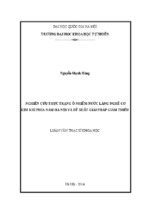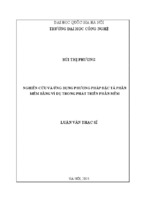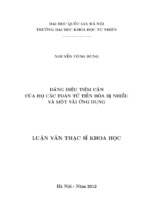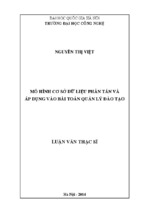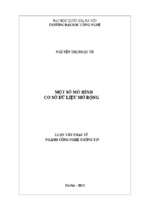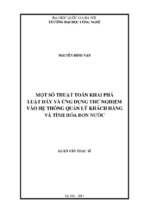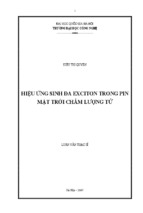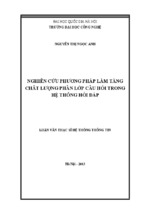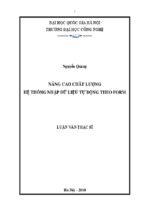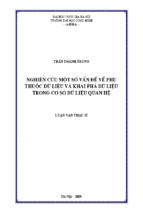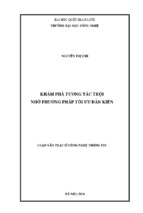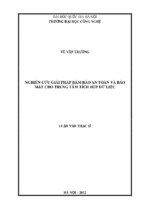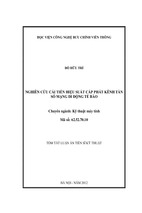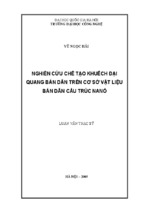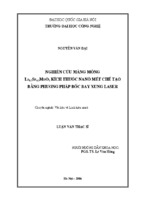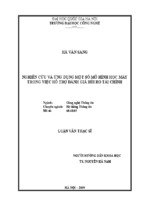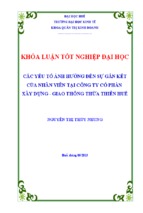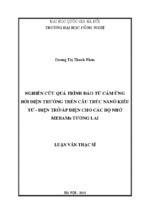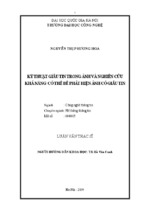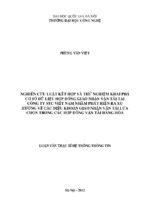Ph.D. Thesis
LEADER-FOLLOWER FORMATION CONTROL
USING ON-BOARD SENSORS IN NOISY ENVIRONMENT
The Graduate School
YEUNGNAM UNIVERSITY
Department of Electrical Engineering
Robotics and Control Major
TRAN VIET HONG
Advisor: Professor Lee Suk Gyu
December 2010
Ph.D. Thesis
LEADER-FOLLOWER FORMATION CONTROL
USING ON-BOARD SENSORS IN NOISY ENVIRONMENT
Advisor: Professor Lee Suk Gyu
Presented in Partial Fulfillment
of the Requirements
for the Degree of
Doctor of Engineering
December 2010
The Graduate School of Yeungnam University
Department of Electrical Engineering
Robotics and Control Major
TRAN VIET HONG
Tran Viet Hong’s Ph.D. Thesis is approved by
Committee members
Professor Lee, Ki Dong
Professor Lee, Suk Gyu
Professor Lee, Hai Young
Professor Park, Ju Hyun
Professor Lee, Jeh Won
December 2010
The Graduate School of Yeungnam University
Acknowledgments
To be accepted for a PhD position at Robotics and Control Laboratory,
Department of Electrical Engineering, Yeungnam University under the
supervision of Professor Lee Suk-Gyu is like a fate. Right at the first meeting
with him, I felt that this is a good chance for my career. After four years, I have
had a happy time and learnt a lot. I have even more experience of a new
academic life and a new culture when following PhD course abroad.
Looking back on the time that I spent to study and finish this thesis, I must
admit that I enjoyed doing this research very much, even though it was not easy.
I am glad to recall many wonderful people who accompanied me in that tough
road to assist me in various ways. I cannot reach this point by only myself.
First and foremost, my very special thank gives to Professor Lee Suk-Gyu for
giving me a chance to do research on simultaneous localization and mapping,
and multi-robot system. His expertise, motivation, enthusiasm, understanding,
and patience, taken together, make him a great mentor. Thank you for directing
me through my research and for all your help during my stay.
Many thanks go to Professors at Yeungnam University, in general, and
Department of Electrical Engineering, in particular, who gave me valuable
lectures and advices. Especially, I would like to express my sincere
appreciation to Professor Noh Seok-Kyun, my wife’s supervisor, for his
valuable and numerous help to our living in Korea.
I would like to thank the members of my thesis committee, Professor Lee
Ki-Dong, Professor Lee Hai-Young, Professor Jessie Park Ju-Hyun and
Professor Lee Jeh-Won to kindly for their time, interest, and helpful
suggestions and comments.
I consider myself fortunate to be with all of my past and present colleagues in
Robotics and Control Laboratory and other laboratories such as Wee Sung-Gil,
- iv -
Park Je-Yong, Kim Jong-Uk, Joo Jin-Hwan, Lee Ho-Geun, Dilshat Saitov, Choi
Kyung-Sik, Choi Yun-Won, Kim Kyung-Dong, Ryu Hee-Rack, Im Sung-Gyu,
Jo Young-rae, Qu Xiaochuan, Xu Zhiguang, Dai YanYan, Liu Fenggang, Lee
Tae-Hee, Kim Hon-Hee, and too many others to put all your names here.
With great appreciation, I shall acknowledge Hochiminh city University of
Technology (Vietnam National University, Hochiminh city), Faculty of
Mechanical Engineering for the permission to study abroad.
I will never forget four years of living with a solidary and affectionate
community of Vietnamese students in Yeungnam University. You helped me to
overcome the difficulties of living abroad. Thanks also go to Vietnamese
students in Korea for kind help, encouragement, friendship, and happy times.
And last but not least, I deeply thank Doctor Park Jung-Tae and Doctor Park
Jin-Wook for your patience to take care of the health for my family.
Mommy and daddy, please receive my gratitude for sacrificing your lives for us,
and providing unconditional love and care. Viet Hung, my brother, is a
wonderful model of scientific passion that gives me more self-confidence. It is
lucky to have Nhon, my sister-in-law, here with us. Her help is invaluable. I am
also very grateful to my wife’s family who have dealt with my personal issues
in Vietnam, and encouraged me constantly. Finally, my wife is one
extraordinary person deserving most of the acknowledgements. She is always
right beside me with listening ears, loving smiles and gives me the feeling of
warmth, hope and peace. Especially, she is spending the hard time in Vietnam
to prepare for delivering our first baby.
December 2010
Tran Viet Hong
Yeungnam University, South Korea.
-v-
Contents
Acknowledgments
iv
Contents
vi
List of tables
viii
List of Figures
ix
List of Abbreviations
xii
Abstract
xiii
CHAPTER 1
Introduction
14
1.1. Problem overview ..................................................................................... 14
1.2. Contributions and outline of the thesis ...................................................... 18
CHAPTER 2
Formation and Formation Control
20
2.1. Introduction to formation .......................................................................... 20
2.1.1. Applications of formation............................................................. 21
2.2. Introduction to formation control .............................................................. 25
2.2.1. Formation control structures......................................................... 26
2.2.2. Formation control approaches ...................................................... 29
2.2.3. A leader-follower formation example and basic tasks to be
controlled ...................................................................................... 32
2.3. Motivation ................................................................................................. 34
CHAPTER 3
Stable On-board Sensor Based Formation Control in the
Presence of Obstacles
38
3.1. Problem Statement .................................................................................... 39
3.1.2. Robot model ................................................................................. 40
3.1.3. Formation control framework for SLSF scheme .......................... 41
3.2. Proposed Control ....................................................................................... 43
3.2.1. Formation control framework for TLSF scheme .......................... 43
3.2.2. Proposed control law .................................................................... 45
- vi -
3.3. Obstacle Avoidance Algorithm .................................................................. 49
3.3.2. Flowchart ...................................................................................... 51
3.3.3. Choose new desired position ........................................................ 53
3.3.4. Stability of obstacle avoidance algorithm .................................... 54
3.4. Simulations and Analysis .......................................................................... 54
3.4.1. First simulation: small-scale robot team, merits of TLSF
scheme .......................................................................................... 55
3.4.2. Second simulation: big-scale robot team, merits of TLSF
scheme .......................................................................................... 61
3.4.3. Third simulation – formation switching ....................................... 63
3.4.4. Fourth simulation – single obstacle .............................................. 65
3.4.5. Fifth simulation – multiple obstacles, schemes switching ........... 68
3.5. Summary and Possible Extensions ............................................................ 70
CHAPTER 4
Wavelet-based Methods to Enhance Sonar Measurement
72
4.1. Introduction ............................................................................................... 73
4.2. Related works ............................................................................................ 75
4.2.1. Direct Cross Correlation (CC) ...................................................... 75
4.2.2. Generalized Cross Correlation (GCC).......................................... 76
4.2.3. Wavelet-based Generalized Cross Correlation ............................. 77
4.3. Enhanced Wavelet-based Methods ............................................................ 79
4.3.2. Improved Wavelet Pre-filter GCC (IWP-GCC) ........................... 80
4.3.3. Improved Wavelet-domain Inner Product GCC (IWDIP) ............ 82
4.3.4. Computational complexity comparison ........................................ 85
4.4. Simulation Results..................................................................................... 87
4.4.1. Performance analysis .................................................................... 87
4.4.2. Application in formation control .................................................. 91
4.5. Summary and Possible Extensions ............................................................ 97
CHAPTER 5
Conclusions and Future Research
99
5.1. Summary of contributions ....................................................................... 100
5.2. Future research directions ....................................................................... 101
Bibliography
103
Appendix A
Calculation of ϕkm
115
Appendix B
Proof of Lyapunov stability
117
- vii -
List of tables
Table 3.1
Parameters of the first simulation
55
Table 3.2
Displacement errors of control law [GH08]
61
Table 3.3
Displacement errors of control law (3.14)
61
Table 3.4
Parameters of the third simulation
63
Table 3.5
Displacement errors of control law [GH08] in third
simulation
65
Displacement errors of control law (3.14) in third
simulation
65
Table 3.7
Parameters of the fourth simulation for 4-robot team
67
Table 3.8
Parameters of the fifth simulation
68
Table 4.1
Computational time using Matlab
91
Table 4.2
Error range of each method when SNR < –40dB
92
Table 4.3
Displacement errors of control law (3.14) at various error
levels
95
Table 3.6
Table 4.4
Relation between increment of std
- viii -
∆d
dk 0
and increment of ed
96
List of Figures
Figure 1.1
Examples of biological systems exhibiting cooperative
behaviors
15
Figure 1.2
Applications of formation control
16
Figure 1.3
Block diagram of a mobile robot
17
Figure 1.4
Outline of the thesis in corresponding with block diagram
of the robot
18
Figure 2.1
Formation of UGVs working in a terrain and a field
22
Figure 2.2
Some applications of formation of UAVs and satellites
24
Figure 2.3
Two applications of formation on and under water
25
Figure 2.4
Centralized and decentralized structures
26
Figure 2.5
Motion and formation process of a group of robots with
three basic tasks: forming, maintaining, and obstacle
avoiding.
33
(a) SLSF scheme in diamond formation
(b) SLSF scheme in zigzag formation
(c) TLSF scheme in diamond formation
of a four-robot team.
40
Figure 3.2
SLSF scheme
41
Figure 3.3
TLSF scheme
43
Figure 3.4
TLSF scheme with detailed information
45
Figure 3.5
An example of TLSF scheme in obstacle avoidance with
one obstacle
50
An example of TLSF scheme in obstacle avoidance with
two obstacles
50
Figure 3.1
Figure 3.6
- ix -
Figure 3.7
TLSF scheme control without obstacle avoidance.
52
Figure 3.8
TLSF scheme control with obstacle avoidance algorithm.
52
Figure 3.9
Choose new desired position for follower robot to avoid
obstacle
53
Figure 3.10 Performance of (a) control law [GH08] and
(b) control law (3.14).
57
Figure 3.11
58
Trajectory seen from leader robot R0 of (a) R1 and (b) R2.
Figure 3.12 Relative distance over time between
(b) R2 and R0.
(a) R1 and R0 and
59
Figure 3.13 Relative bearing angle over time between (a) R1 and R0,
and (b) R2 and R0.
60
Figure 3.14 Performance of a team of 5 robots using (a) the control
law [GH08] and (b) the control law (3.14) in the TLSF
scheme.
62
Figure 3.15 Performance of a team of 3 robots in switching from
a triangular formation to a line formation using
(a) control law [GH08] and (b) control law (3.14)
64
Figure 3.16 Robot team avoids a single obstacle when switching from
formation ΩC to ΩD
66
Figure 3.17 Robot team avoids a single obstacle in maintaining
formation ΩE.
67
Figure 3.18 Robot team avoids obstacles without changing role of
local leaders (formation ΩF).
69
Figure 3.19 Robot team avoids obstacles with changing roles
(formation ΩF before the first obstacle and formation ΩG
after the first obstacle).
70
Figure 4.1
Direct cross correlator configuration
75
Figure 4.2
A generalized cross correlator configuration [AH84]
76
-x-
Figure 4.3
Wavelet Pre-filter GCC configuration
77
Figure 4.4
Wavelet-domain inner product GCC (WDIP) configuration
78
Figure 4.5
Denoise and recognition comparison.
80
Figure 4.6
Original WP-GCC process
80
Figure 4.7
Improved WP-GCC process
(a) Delay prediction in the wavelet domain
(b) Calculate the delay by the cross correlation in the
time domain
82
Improved WDIP process
(a) Delay time calculation
(b) Optimal cross correlation
84
Block diagram of the simulation process
87
Figure 4.8
Figure 4.9
Figure 4.10 The transmitted signal
88
Figure 4.11
89
The received signal at SNR = –10 dB
Figure 4.12 The delay error rate versus the SNR
90
Figure 4.13 Trajectories of 5 robots when ed = 42%
92
Figure 4.14 Trajectory of robot R2 when no error, ed = 30%
and ed = 42%
93
Figure 4.15 Trajectory of robot R3 when no error, ed = 30%
and ed = 42%
93
Figure 4.16 Trajectory of robot R2 in R0 coordinate when no error,
ed = 30% and ed = 42%
94
Figure 4.17 Trajectory of robot R3 in R0 coordinate when no error,
ed = 30% and ed = 42%
94
- xi -
List of Abbreviations
CC
Cross Correlation
DSP
Digital Signal Processing
DWT
Discrete Wavelet Transform
EERUF
Error Eliminating Rapid Ultra-sonic Firing
FFT
Fast Fourier transform
GCC
Generalized Cross Correlation
IWDIP
Improved Wavelet-Domain Inner Product GCC
IWP-GCC
Improved Wavelet Pre-filter GCC
PHAT
Phase Transform
SCOT
Smoothed Coherent Transform
SLSF
Single Leader – Single Follower
SNR
Signal-to-Noise Ratio
Sym8
Symplet whose vanishing moment is 8
TLSF
Two Leaders – Single Follower
UAV
Unmanned Air Vehicle
UGV
Unmanned Ground Vehicle
UUV
Unmanned Underwater Vehicle
WDIP
Wavelet-Domain Inner Product GCC
WP-GCC
Wavelet Pre-filter GCC
- xii -
Abstract
This thesis addresses three problems of leader-following formation control for
multiple non-holonomic mobile robot system: stable control using only
on-board sensors, obstacles avoidance, and noise’s effect reduction.
Specifically, via kinematic analysis, we estimate the leaders’ translational and
angular accelerations to build a stable controller whose inputs are only distance
and angle information acquired from on-board sensors (do not need to measure
velocities of leader robot). In addition, the controller is common for both single
leader – single follower (SLSF) and two leaders – single follower (TLSF)
schemes in order to have an ability of flexible switching between those
schemes. Taking full advantage of this ability, we also extend the function of
the controller by an obstacle avoidance algorithm to help the formation
overcome harassment of static obstacles in the environment. Moreover, because
of high error from distance measurement by using ultrasonic sensor, the
stability property is not enough for disturbance rejection. Therefore, we present
two enhanced wavelet-based method as a supplement to ability of reducing
effect of noise. Although, the controller is such multi-functional and effective,
it is still simple for quick processing, so that the time delay is kept small.
Theoretical and simulation analysis show that all the functions of the controller
work very well and rapidly. The controller can work with any scale of the robot
team, but it shows an advantage in large scale where TLSF scheme can
suppress the oscillation and damping and increase convergence rate of third,
fourth, and succeeding follower robots. Even in the presence of obstacles, the
formation is kept as close as required form and reform when there is no
obstacle. In noisy environment, although the effect of noise is not able to be
fully rejected, even a small measurement error decrement is valuable to
improve the performance of formation control.
- xiii -
CHAPTER 1
Introduction
1.1. Problem overview
Several new robotics application areas, such as underwater and space
exploration, hazardous environments, service robotics in both public and
private domains, the entertainment field, and so forth, can benefit from the use
of multi-robot systems. In these challenging application domains, multi-robot
systems can often deal with tasks that are difficult, if not impossible, to be
accomplished by an individual robot. A team of robots may provide redundancy
and contribute cooperatively to solve the assigned task, or they may perform
the assigned task in a more reliable, faster, or cheaper way beyond what is
possible with single robots. For instance,
•
it is usually more cost-effective to manufacture and deploy a number of
cheap robots rather than a single expensive one
•
higher number yields better potential for a system resilient to
individual robot failures
- 14 -
•
smaller robots have obviously better mobility in tight and confined
spaces, and
•
a group can survey a larger area than an individual robot, even if the
latter is equipped with better sensors.
The field of cooperative autonomous mobile robotics is still new enough that
no topic area within this domain can be considered mature. Some areas have
been explored more extensively, however, and the community is beginning to
understand how to develop and control certain aspects of multi-robot teams
[TEL02].
Therefore, nowadays control and coordination of multi-agent systems has
emerged as a topic of major interest [LC+08]. This is partly due to broad
applications of multi-agent systems in cooperative control of unmanned
vehicles, formation control of swarms, where collective motions may emerge
from groups of simple individuals through limited interactions. The world
around us is teeming with examples of this emergent behavior, from a flock of
birds to a school of fish, a herd of wildebeest to a swarm of locusts. In physics,
a flock can be defined as the coherent motion of a group of self-propelled
particles emerging from a single set of interactions between the constituents of
that group. Some examples of biological systems exhibiting cooperative
behaviors are shown in Fig. 1.1.
Figure 1.1 Examples of biological systems exhibiting cooperative behaviors
- 15 -
Many swarm systems, such as flying wild geese, fighting soldiers, and robots
performing a task, always form and maintain a certain kind of formation
according to overlapping information structure constraints [XC08]. In practice,
forming and maintaining desired formations would have great benefits for the
system to perceive unknown or partially known environment, to perform its
tasks. Some applications of formation control are shown in Fig. 1.2.
Figure 1.2 Applications of formation control
For its wide range of applicability, the formation control problem has
stimulated a great deal of research in recent years. By formation control we
simply mean the problem of controlling the relative position and orientation of
the robots in a group while allowing the group to move as a whole. This thesis
focuses on developing a formation controller for a team of mobile robots
(wheeled mobile robots with non-holonomic constraints) moving in a 2D space.
- 16 -
The robot in the team has limited communications and uses only on-board
sensor for sensing. The block diagram of a robot in this research is shown in
Fig. 1.3. This means that the focus is on the formation task control only and is
neither going into the details of the formation protocols for coordinating and
organizing the grouped robots to accomplish the formation task, nor collision
avoidance.
On-board sensors
Sensing the
environment
Sensing the
leaders
Obstacle avoiding
controller
Formation
controller
Controller
Control
signal
Motors
Figure 1.3 Block diagram of a mobile robot
However, the formation control also considers avoiding static obstacles in
environment. In addition, we also propose methods to improve the accuracy
and calculation time for ultrasonic sensor measurement to provide the accurate
sensing data and give them to the controller on time. In summary, the thesis
deals with the problems in three blocks: on-board sensors, obstacle avoiding
controller, and formation controller as shown in Fig. 1.3.
- 17 -
1.2. Contributions and outline of the thesis
As aforementioned in Section 1.1, the proposed methods to solve the problems
in each block in Fig. 1.3 will be presented in each chapter. The correspondence
between chapters and blocks are shown in Fig. 1.4.
Chapter 4
On-board sensors
Sensing the
environment
Sensing the
leaders
Chapter 3
Obstacle avoiding
controller
Formation
controller
Controller
Control
signal
Motors
Figure 1.4 Outline of the thesis in corresponding with block diagram of the
robot
In Chapter 2, an overview about formation and formation control is presented.
Because the formation issue has been studied for a long time, there is a huge
amount of information about it. This chapter tries to summarize it briefly, but
still sufficiently, from general information such as the importance and
applications, to specific information such as research directions in formation
control, and up-to-date achievements.
Chapter 3 deals with two scenarios.
In the first scenario, the robot team is assumed to keep a formation in an
- 18 -
obstacle-free environment by leader-follower scheme. Every robot has limited
communication with other robots in team, and uses only on-board sensor to
sense the environment. Due to those limitations, it is very difficult for the robot
to measure velocity of its leader robot. A TLSF scheme observer-based
controller is proposed to overcome this difficulty by approximation of both
translational and angular accelerations of the leader robot via kinematic
analysis which have not used by any researcher in the literature. This control
law stability is proved by Lyapunov stability theory.
In the second scenario, the group of robots is considered to be able to meet
static obstacles when moving. To take full advantage of TLSF scheme
controller and to keep the easiness in application, an obstacle avoiding
algorithm is added to the proposed formation control algorithm. The obstacle
avoiding algorithm is simple, yet can keep the stability of the formation control
algorithm and show good performance.
In the above scenarios, there is no noise in the environment. Because the
formation control is based mainly on the measurement from on-board sensors,
and noise affects much to the accuracy of sensing data, the measurement must
assure to be accurate, or the performance of the whole system will be decreased.
In addition, while a fusion of sensors is often used, it is required that data
should be processed and sent to the controller as quick as possible. This is like
a chicken and egg problem. The more accurate and free of noise data have
come, the more time to process is required. In Chapter 4, the improvement in
accuracy and processing time of ultrasonic sensors will be considered. As an
improvement over the existing literature, two wavelet-based methods using
prediction technique are proposed to help ultrasonic sensors getting distance
information quickly and precisely.
In the last chapter, Chapter 5, major contributions of the thesis are summarized,
and some possible directions for research in the future are highlighted.
- 19 -
CHAPTER 2
Formation and Formation Control
2.1. Introduction to formation
Collective robotics studies the different ways of using autonomous robot teams
to efficiently fulfill predefined missions. In collective robotics, several new
problems have been lately introduced [RB08], such as:
•
consensus [CMA08, Mor05, OFM07, Tsi84]
•
rendezvous [AO+99, LMA07]
•
cyclic pursuit [MB08, MBF04, PF07, SG06]
•
coverage and deployment [CM+04, HMS02]
•
formation control [AY+08, DF08, FM04, OEH02]
•
connectivity/visibility maintenance [DK08, ME07, ZP08, SNB09].
Among them, formation has received a lot of attention. In formation problems,
a team of mobile robots establish and maintain predetermined geometrical
shapes by controlling the location of each robot relative to the group while
allowing the group to move as a whole. Geometric formation can be
- 20 -
- Xem thêm -


